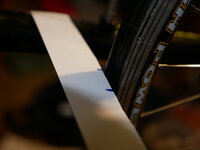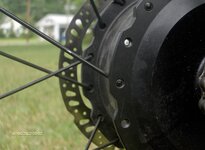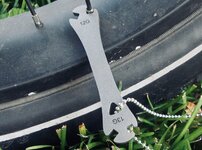You are using an out of date browser. It may not display this or other websites correctly.
You should upgrade or use an alternative browser.
You should upgrade or use an alternative browser.
Correct spoke tension, 2019 Rad Rover rear wheel?
- Thread starter Pay Jota
- Start date
spokewrench
Well-Known Member
- Region
- USA
I believe tension tools came along for very light road-bike spokes and rims, and even then, many mechanics go by feel.
Adjusting by sound has worked for me with 4 e-bikes (including a Radrunner and a Radmission). I get the wheel off the ground and tap spokes with my spanner-style spoke wrench. The first time around, I tighten the dead-sounding ones and occasionally loosen one that sounds tauter than the rest. The second time around, I get them sounding pretty much the same.
A dead-sounding spoke could allow enough lateral movement to increase wear and affect handling. I've sometimes noticed improved handling after adjusting spokes on a new bike.
Adjusting by sound has worked for me with 4 e-bikes (including a Radrunner and a Radmission). I get the wheel off the ground and tap spokes with my spanner-style spoke wrench. The first time around, I tighten the dead-sounding ones and occasionally loosen one that sounds tauter than the rest. The second time around, I get them sounding pretty much the same.
A dead-sounding spoke could allow enough lateral movement to increase wear and affect handling. I've sometimes noticed improved handling after adjusting spokes on a new bike.
mrgold35
Well-Known Member
- Region
- USA
- City
- ABQ, New Mexico
I have two 2016 Radrovers, 2018 Radcity, and 2023 Radcity. I've noticed the spokes from the factory had various tension and sometimes caused a "ticking" sound when riding and some slight wheel wobble. I purchased the round 8-way spoke nipple key wrench (Amazon, $2.60) and set even tension on all spokes. Some spokes were tight and others needed up to 1/2-to-several 360 degree turns to get to the same tension. Zero clue of the tq applied to each spoke; but, results are no ticking sound and having the wheel spin more true (eliminating the wobble help adjust brake pad distances with little to no wobble rubbing).

spokewrench
Well-Known Member
- Region
- USA
I had to replace maybe 4 spokes on the rear wheel of my Radrunner. In the photo, the heads had popped off where the holes are. I read that most breaks are near the threads or at the elbow. The broken heads were a mystery until I noted the sunken head between the holes. The head was too small, letting it sink too deep, giving the elbow leverage to stretch and put uneven pressure around the head. When that third spoke broke, the bike would have been unrideable. I walked a lot during the month it took spokes to arrive from China.I have two 2016 Radrovers, 2018 Radcity, and 2023 Radcity. I've noticed the spokes from the factory had various tension and sometimes caused a "ticking" sound when riding and some slight wheel wobble.
The other photo shows the kind of wrench I prefer. It's a handy hammer to sound spokes. Fingers don't have to work between spokes. It'll grip a nipple by 3 corners, and the dogtag chain quickly identifies which end is which.
Attachments
Last edited:
Urbancowboy
Active Member
- Region
- Canada
I just received a Spoke tension Tool. Unfortunately it wont work on my eBike because the Pins are to far apart (or the available space on the Spokes on my eBike) is to short.
Any suggestions by the Experts other then going by sound.
Cheers
Any suggestions by the Experts other then going by sound.
Cheers
PCeBiker
No-Hands No-Pedaling No-Credentials
- Region
- Canada
Any suggestions by the Experts other then going by sound.
Grab the spokes where they cross, and squeeze,..
You'll feel it, see it, And hear it.
Don't go too crazy tightening anything, or you'll warp your wheel.
Mark the ones you mess with so you can undo what you did if you have to.
A loose spoke should be easy to identify.
Properly tensioned ones are difficult.
Don't try to make them all sound the same, just focus on the ones that rattle and snug them up till they stop rattling. (or you'll warp the wheel)
PS. I'm not an expert, but I've been warping and unwarping wheels since I was 12 years old.
PCeBiker
No-Hands No-Pedaling No-Credentials
- Region
- Canada
I actually bought a spoke tension gauge and used it to tension every spoke exactly to spec.
My wheel was so warped it hit the chain stay.
I had to undo everything I did to straighten the wheel. Then bring the tightest spokes down into the upper tension range, and bring the loosest spokes up into lower tension range.
What a PITA.
Turns out my 26" fat rim is a warped piece of crap and wasn't joined together squarely when it was made.
My wheel was so warped it hit the chain stay.
I had to undo everything I did to straighten the wheel. Then bring the tightest spokes down into the upper tension range, and bring the loosest spokes up into lower tension range.
What a PITA.
Turns out my 26" fat rim is a warped piece of crap and wasn't joined together squarely when it was made.
Urbancowboy
Active Member
- Region
- Canada
You may not be an "Expert" but I like your advise because it makes sense thank you !Grab the spokes where they cross, and squeeze,..
View attachment 185872
You'll feel it, see it, And hear it.
Don't go too crazy tightening anything, or you'll warp your wheel.
Mark the ones you mess with so you can undo what you did if you have to.
A loose spoke should be easy to identify.
Properly tensioned ones are difficult.
Don't try to make them all sound the same, just focus on the ones that rattle and snug them up till they stop rattling. (or you'll warp the wheel)
PS. I'm not an expert, but I've been warping and unwarping wheels since I was 12 years old.
harryS
Well-Known Member
Self taught spoke guy. The sound that matters is when you hear the wheels tinkle when a loose spoke pops in and out as the wheels roll, Those are easy to find by squeezing the spokes, .and I'll just tighten the spoke til it feels like others,
I've built quite a few wheels, most with motors. Nine years ago, going into a bike shop with a rim and motor, they would recoil either in fear or arrogance. If I wanted it done, had to learn how to do it myself. Sure, made some mistakes.
Benefit is I know how to keep my wheels true. When they're tight enough, a 1/2 turn on two adjacent spokes can move the rim pretty far. I don't own a tension meter. I mostly use 14G spokes, sometimes 13G. Never had any break.
I've built quite a few wheels, most with motors. Nine years ago, going into a bike shop with a rim and motor, they would recoil either in fear or arrogance. If I wanted it done, had to learn how to do it myself. Sure, made some mistakes.
Benefit is I know how to keep my wheels true. When they're tight enough, a 1/2 turn on two adjacent spokes can move the rim pretty far. I don't own a tension meter. I mostly use 14G spokes, sometimes 13G. Never had any break.
PCeBiker
No-Hands No-Pedaling No-Credentials
- Region
- Canada
The spokes from one side of the flange are set to a different tension than the other side, all depending on if the wheel is dished and by how much.
I just center the tire in the frame between the chain stays, or between the fork stanchions.
Make sure your axle is properly seated in the dropouts and that the drop-outs aren't worn or sloppy, or your axle won't be square with the frame or forks.
Last edited:
harryS
Well-Known Member
Rear wheels need to be dished to account for the gears. The spoke calculators will give you different length spokes on opposite sides to account for the offset. I believe that reduces the differences in spoke tension on opposite sides.
Ten years ago, when I had wheels not properly dished, I'd be putting the axle into the dropouts at an angle to get them to spin between the rim brakes. Then I learned dishing and I never have to listen to scraping brakes no more.
Ten years ago, when I had wheels not properly dished, I'd be putting the axle into the dropouts at an angle to get them to spin between the rim brakes. Then I learned dishing and I never have to listen to scraping brakes no more.
PCeBiker
No-Hands No-Pedaling No-Credentials
- Region
- Canada
I wasnt really aware of dishing and would always true the wheel on the bike using the brakes to align the wheel.
I remember a center pull brake I had like this, where the hole in the frame where you bolt on the caliper wasn't centered.

I figured they kinda dished the frame instead of wheel ?
I'm pretty sure that the dishing takes care of itself if you align wheel with the brakes ?
I remember a center pull brake I had like this, where the hole in the frame where you bolt on the caliper wasn't centered.
I figured they kinda dished the frame instead of wheel ?
I'm pretty sure that the dishing takes care of itself if you align wheel with the brakes ?
gromike
Well-Known Member
- Region
- USA
- City
- City of Dreams
Though we have gone to disk brakes. But just the same, you center the wheel.
I'm on my third lace a wheel to a hub motor. There is an art where you feel on torque on one side and a different one on the other.
It's not something for someone who looks for perfection, because there be where madness lies.
I'm on my third lace a wheel to a hub motor. There is an art where you feel on torque on one side and a different one on the other.
It's not something for someone who looks for perfection, because there be where madness lies.
PCeBiker
No-Hands No-Pedaling No-Credentials
- Region
- Canada
I'm on my third lace a wheel to a hub motor.
Turns out my 26" fat rim is a warped piece of crap and wasn't joined together squarely when it was made.
I've never laced a wheel but I'm thinking about lacing in a 27.5" rim to replace my 26" fat rim, then I can install my 27.5" X 2.8" Super Moto-X tires on that ebike.
My new ebike came with a 27.5" rim installed on a fat motor, but the spokes are pulling at a huge angle at the nipples, and it seems Really Wrong to me ??
They are heavy 12 gauge spokes, but still ??
My spoke wrench only fits the nipple for ¼ turn, then I have to reseat it.
Is there a 27.5" X 40 mm rim that is designed to fit a fat motor properly?
Maybe with offset spoke holes or angled spoke holes?
I don't want to build a crappy wheel.
PCeBiker
No-Hands No-Pedaling No-Credentials
- Region
- Canada
It's not something for someone who looks for perfection, because there be where madness lies.
I always try to aim for "Good Enough"
I've fallen down too many
Urbancowboy
Active Member
- Region
- Canada
Obviously a hard Lesson which I am glad you told us about and I am definitely try to avoid, ThanksI actually bought a spoke tension gauge and used it to tension every spoke exactly to spec.
My wheel was so warped it hit the chain stay.
I had to undo everything I did to straighten the wheel. Then bring the tightest spokes down into the upper tension range, and bring the loosest spokes up into lower tension range.
What a PITA.
Turns out my 26" fat rim is a warped piece of crap and wasn't joined together squarely when it was made.
PCeBiker
No-Hands No-Pedaling No-Credentials
- Region
- Canada
I have a hard time leaving well enough alone.
I am forever fixing things that ain't broke until I try to fix them.
Speaking of which, my wheel with the "bent" spokes has been fine now for over 3700 km and me messing with the spokes more than a few times.
I know I should just leave it alone, but it's taking a lot of will power to do so.
I do want to try and install a new rim on the other ebike, but I'm afraid of opening up a big ole can of worms.
I am forever fixing things that ain't broke until I try to fix them.
Speaking of which, my wheel with the "bent" spokes has been fine now for over 3700 km and me messing with the spokes more than a few times.
I know I should just leave it alone, but it's taking a lot of will power to do so.
I do want to try and install a new rim on the other ebike, but I'm afraid of opening up a big ole can of worms.
Last edited:
spokewrench
Well-Known Member
- Region
- USA
Currently I have a single speed e-bike and a derailleur e-bike. Of the 4 wheels, the only one that doesn’t offset the rim from the hub is the one with the cassette. The hub is centered on that one because the cassette on the right balances the brake disk on the left.Rear wheels need to be dished to account for the gears. The spoke calculators will give you different length spokes on opposite sides to account for the offset. I believe that reduces the differences in spoke tension on opposite sides.
For safety and handling, the front contact patch should be centered on the steering axis with the bike straight and level. One bike came from the factory with the front tire offset 5mm. The rim was centered on the hub, but the hub was offset.
The spokes were 250mm, going to nipples 25mm from each hub flange. Pythagoras said that meant the radial distance was 248.7mm.
Pythagoras also said that to change the axial spacing to 20 and 30mm, I needed to extend the spokes on one side 500 microns to 250.5mm and shorten the opposing spokes 500 microns to 249.5mm. One turn on a bicycle nipple is 454 microns. What a coincidence!
My spoke wrench is a 4” spanner that will catch a nipple on 3 corners. The length made it easy to loosen each spoke on one side exactly 1 turn, then tighten exacty 1 turn on the other side. When I finished, I didn’t need further adjustment. The rim had moved 5mm, it ran true, and the spokes sounded good.
For the lateral tensions to balance, spokes on one side would have needed 50% more tension than those on the other. The would be about 4 notes on a music scale, but they rang the same, as do the spokes on 3 other wheels with offset rims.
I grabbed the rim and tried to force it laterally toward the sides of the fork. It wouldn’t budge. If the tire was centered and true and had no lateral play, I considered the task complete.
I think that balancing lateral tension doesn’t matter with 13 and 12 gauge spokes because as long as they aren’t loose, they don’t have enough elastic stretch to let the rim move. An 18-gauge road bike spoke has about 25% of the cross section of a 12-gauge spoke. With greater elastic movement, they may require preloading (tensioning).
Sound tells me no spoke is loose, which could allow lateral rim movement, and none is much tighter than the others, which on a bump could lead to permanent deformation, I suppose.
harryS
Well-Known Member
I use an old fork as my trueing stand, and a piece of tape as my gauge, The pen marks are probably 1 mm wide. Purists that use dial gauges would scorn me.It's not something for someone who looks for perfection, because there be where madness lies.
On the bike, I will put a zip tie on the frame and trim it so it just brushes the rim,

Similar threads
- Replies
- 3
- Views
- 3K
- Replies
- 0
- Views
- 2K

